Abstract
1. We determined the contributions of three independent vasodilator mechanisms (cyclo-oxygenase metabolites, nitric oxide and ATP-sensitive potassium channels) in the mediation of pulmonary vasomotor effects of endothelin-1 (ET-1) in neonatal pigs. 2. Lungs of piglets (2.7 +/- 0.3 days old) were perfused at constant flow (60 ml min-1) with recirculating Ringer-albumin solution. We measured pulmonary artery pressure (Ppa) and the distribution of pulmonary vascular resistance using the double-occlusion method. 3. ET-1 (10(-12)-10(-9) M) produced concentration-dependent pulmonary vasodilatation. ET-1 (10(-9) M) decreased Ppa from 24.5 +/- 3.1 to 17.0 +/- 3.0 cmH2O with a nadir occurring at 1 min, followed by a slow return to baseline over 60 min (time for half-recovery (t1/2R) of 17.2 min). The decrease in Ppa was the result of pulmonary precapillary vasodilatation. Endothelin-3 (ET-3) (10(-12) and 10(-11) M) also induced vasodilatation comparable to equimolar concentrations of ET-1, whereas the selective ETB receptor agonist IRL 1620 at equimolar concentrations caused a more protracted vasodilatation response. 4. Neither the cyclo-oxygenase inhibitor indomethacin (10(-5) M) nor the KATP+ (ATP-sensitive) potassium channel blocker glibenclamide (10(-5) M) significantly altered the baseline Ppa; moreover, neither inhibitor affected the ET-1-induced vasodilatation, indicating the lack of involvement of cyclo-oxygenase metabolites and KATP+ channel activity in the mediation of the pulmonary vasodilator response to ET-1. 5. Addition of 10(-5) M reduced haemoglobin, which antagonizes the action of nitric oxide (NO), increased Ppa over prehaemoglobin levels. Haemoglobin significantly decreased the duration (t1/2R, 3.8 +/- 0.7 min) of pulmonary vasodilatation to ET-1, but did not abolish the initial phase of the response. L-N-Monomethylarginine, an inhibitor of NO synthesis, either alone or in combination with haemoglobin, similarly reduced the duration of ET-1-induced pulmonary vasodilatation. 6. The ETA receptor antagonist [Dpr1-Asp15]-ET-1 (Dpr, diaminoproprionic acid) had no effect on pulmonary vasodilatation induced by ET-1, ET-3 or IRL 1620 (suc-(Glu9,Ala11,15)-ET-1(8-21)). This finding combined with the observed relative potencies of the peptides (IRL 1620 > ET-1 = ET-3) suggests that pulmonary vasodilatation was mediated by activation of the non-selective ETB receptor. 7. The results indicate that the sustained ET-1-induced pulmonary vasodilatation in neonates is probably mediated via ETB receptor activation and that it is critically dependent on NO.
Full text
PDF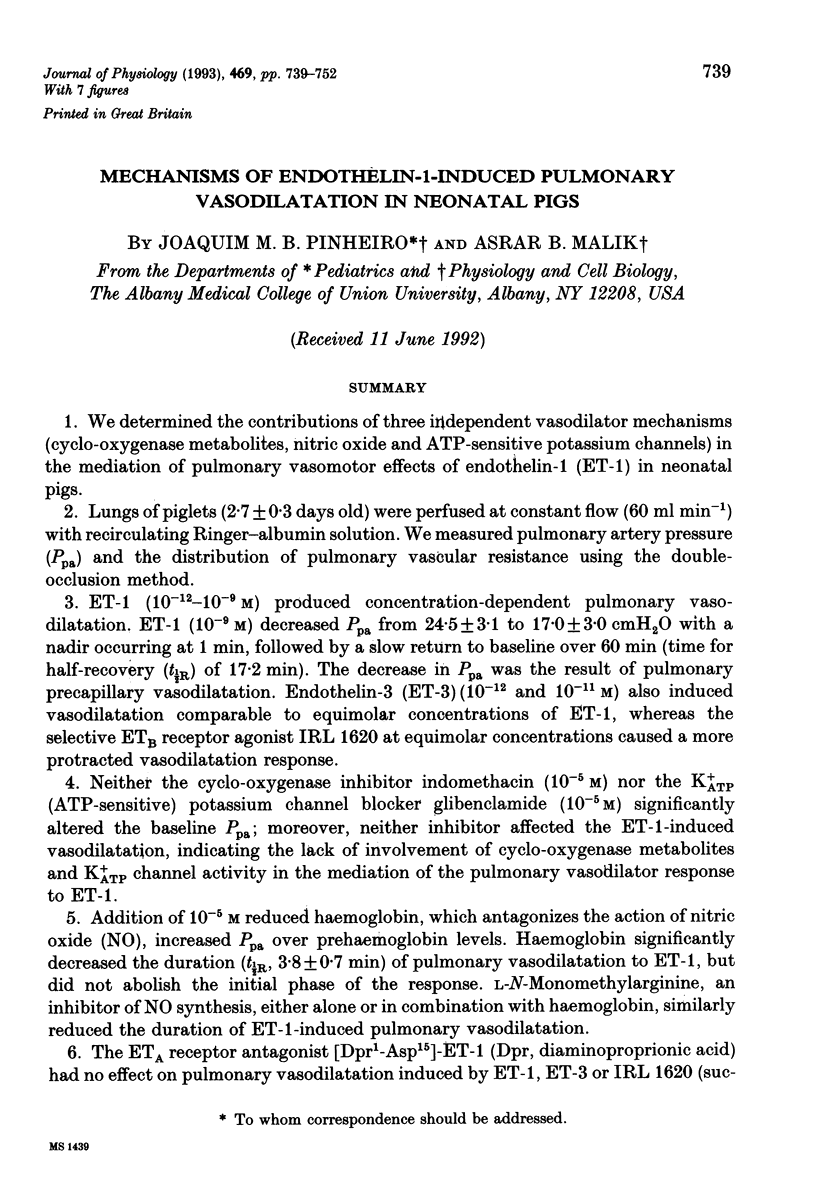
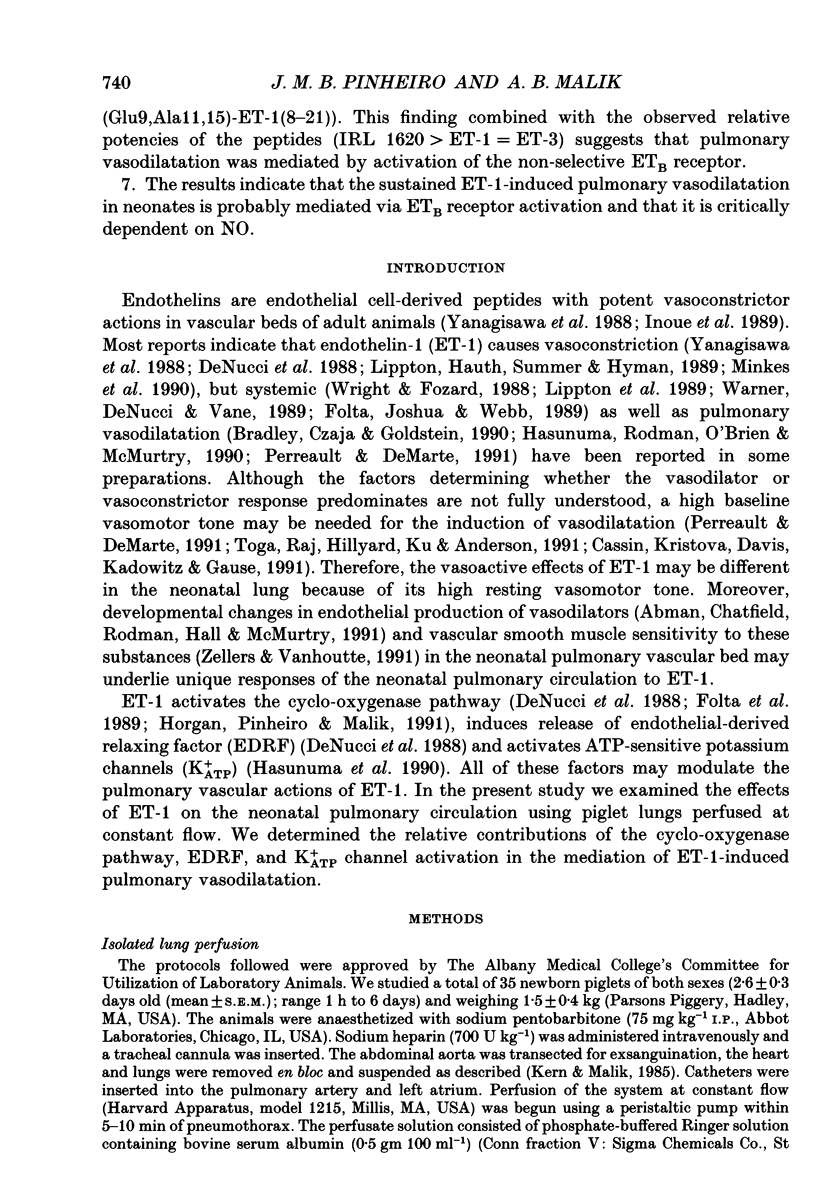
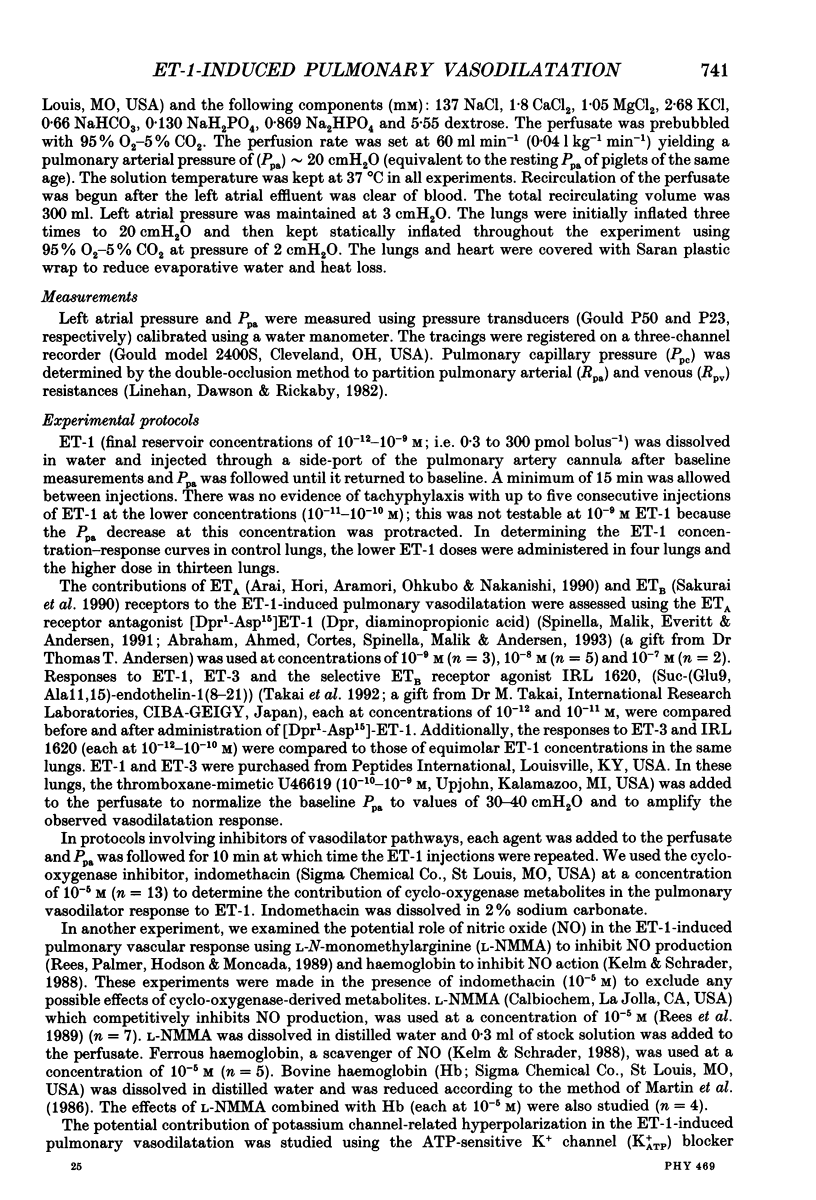
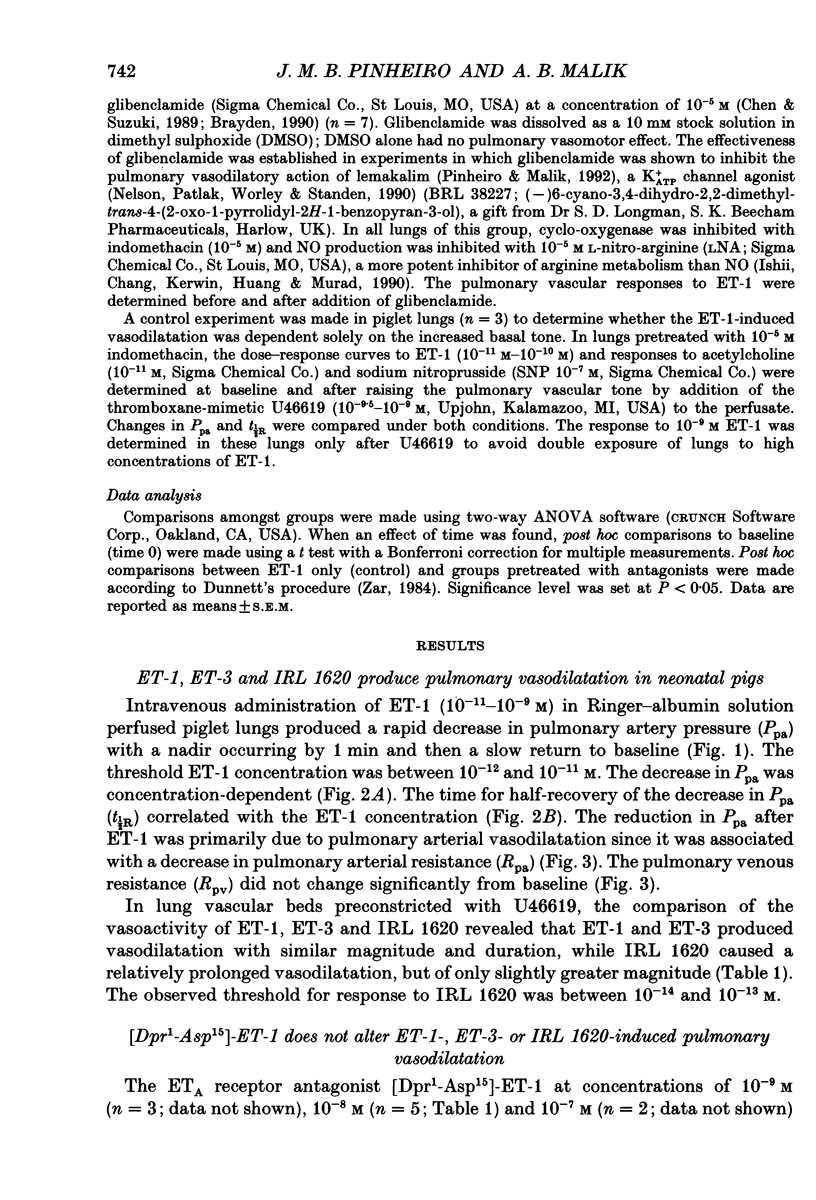
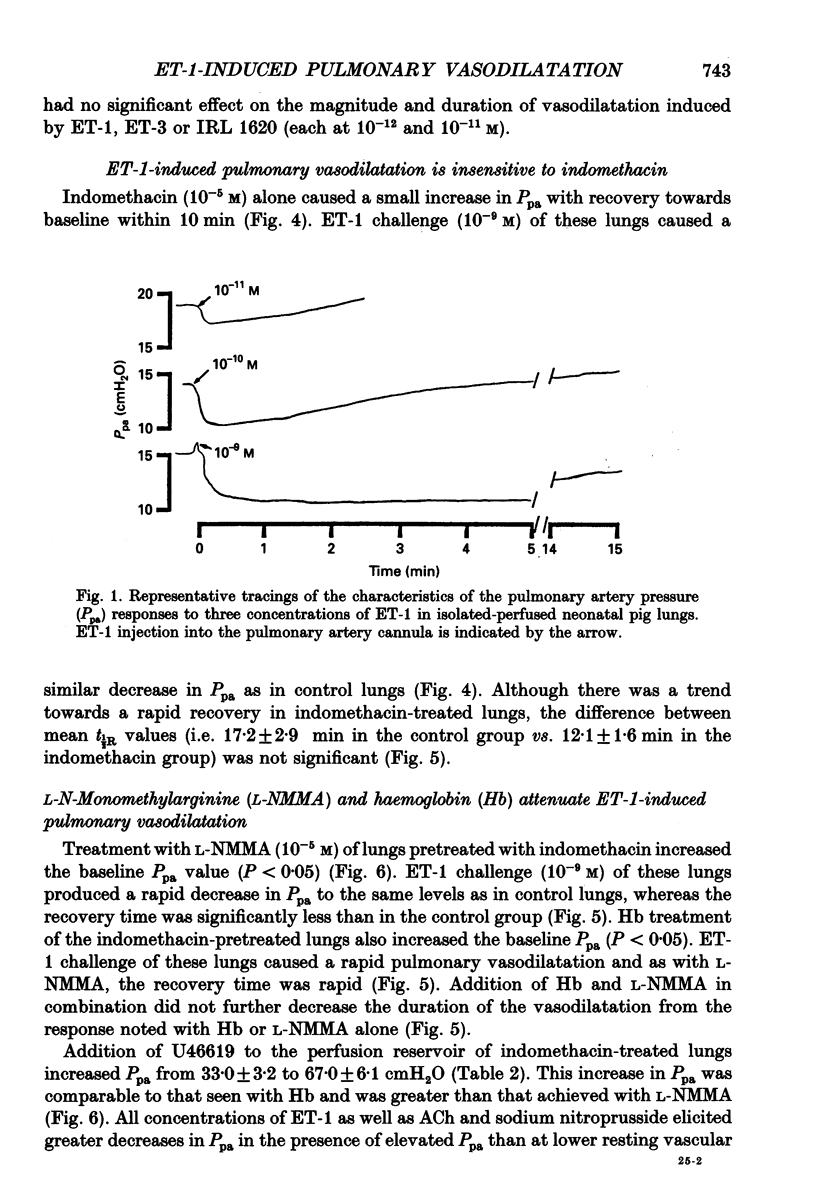
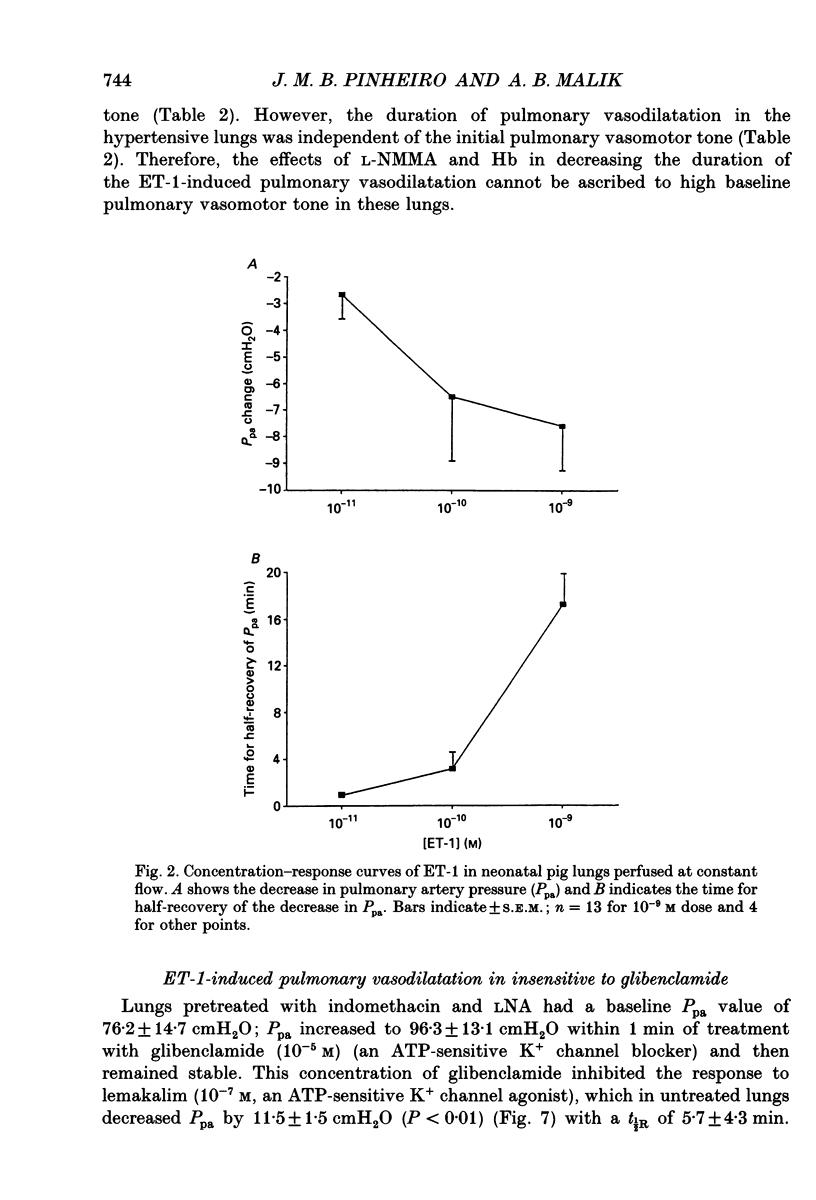
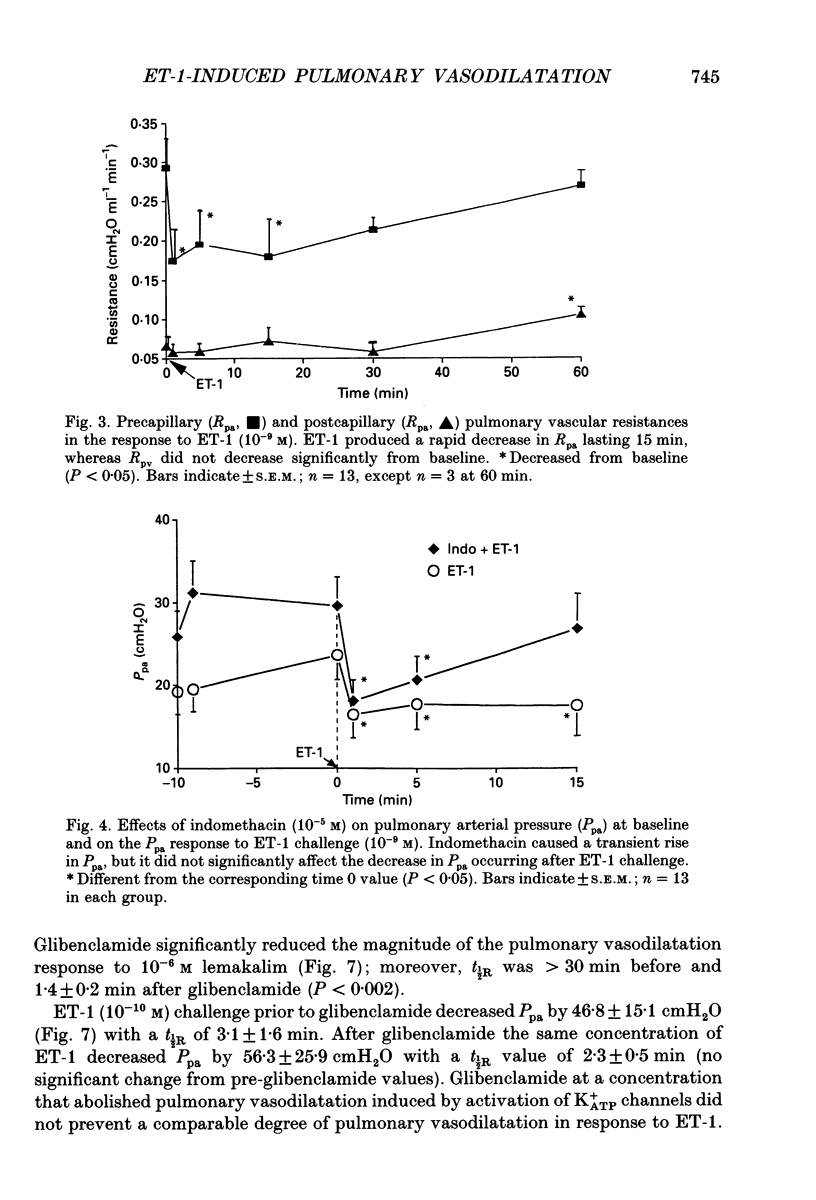
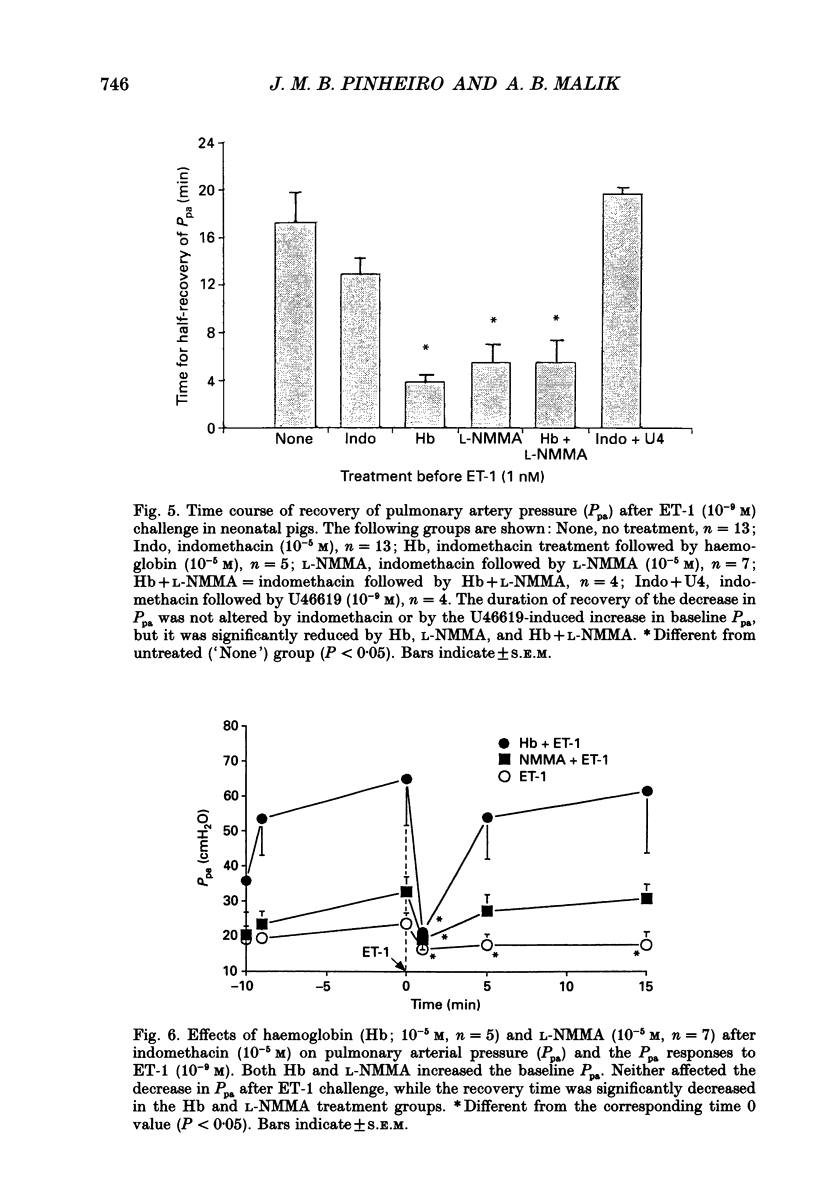
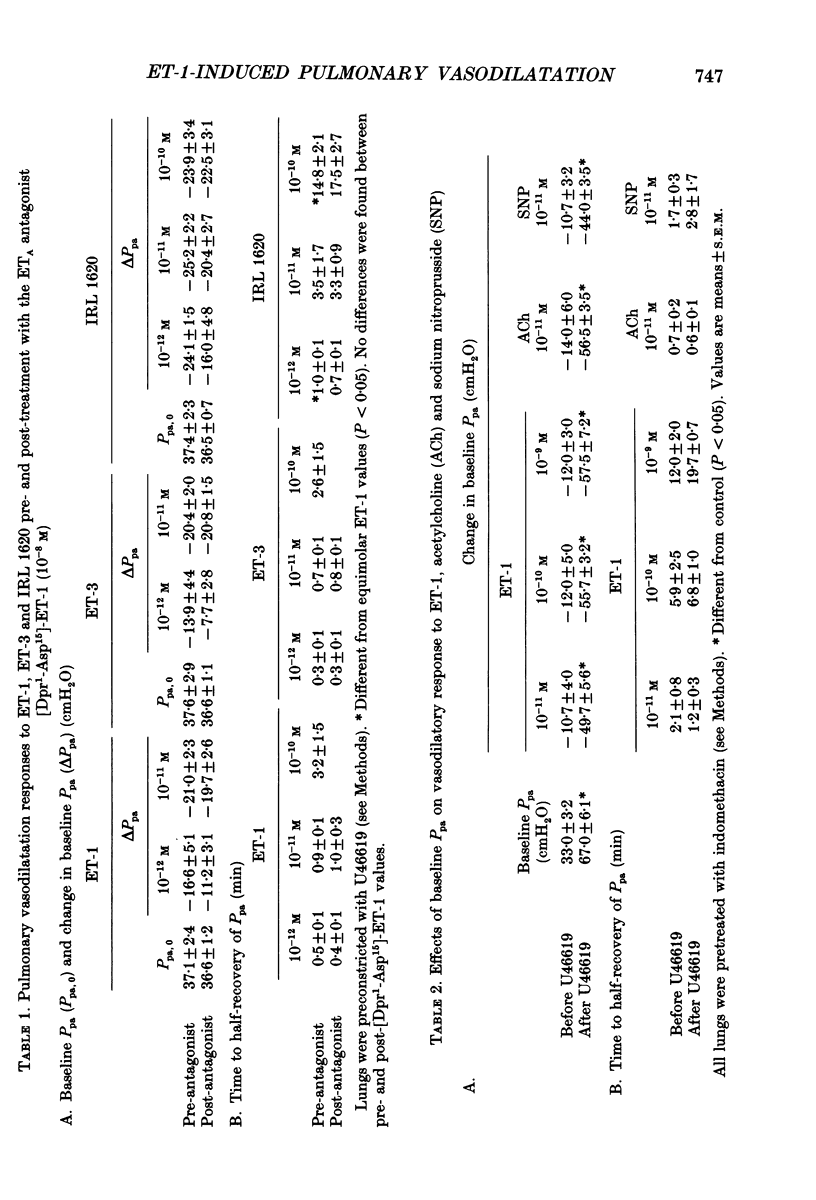

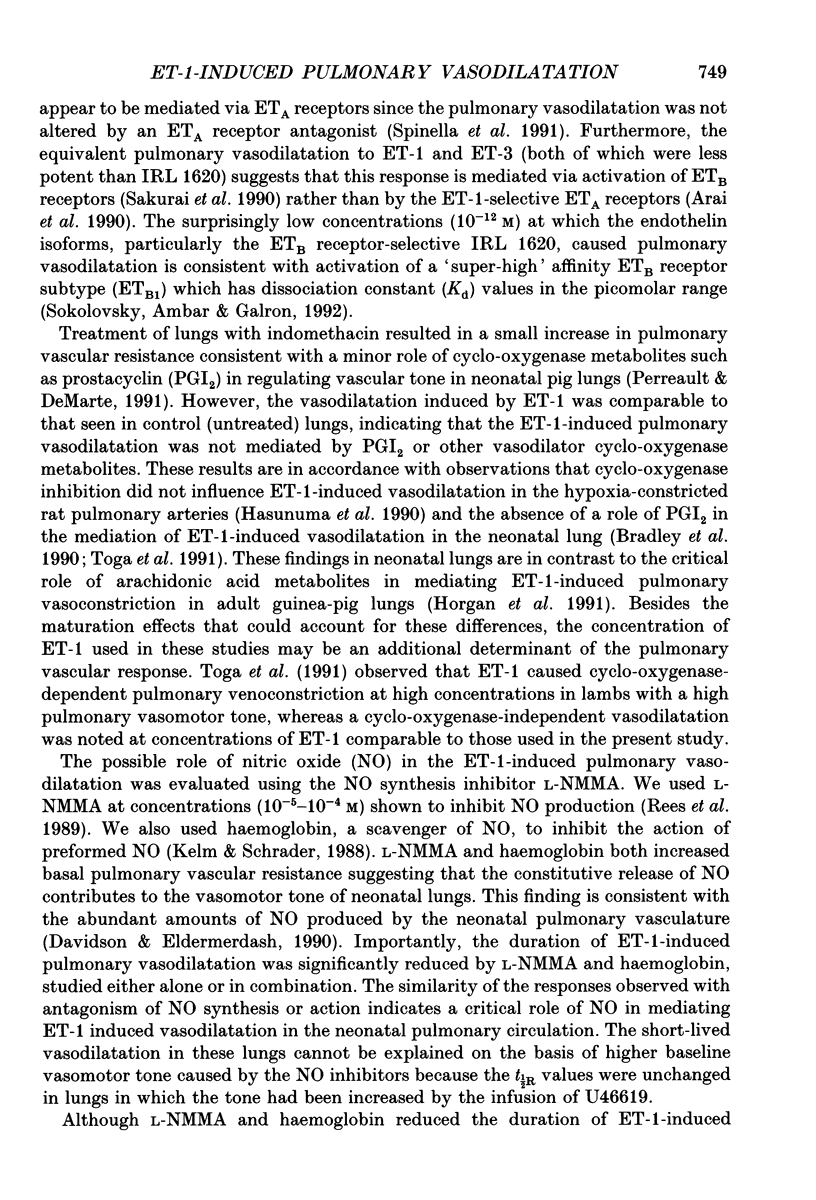
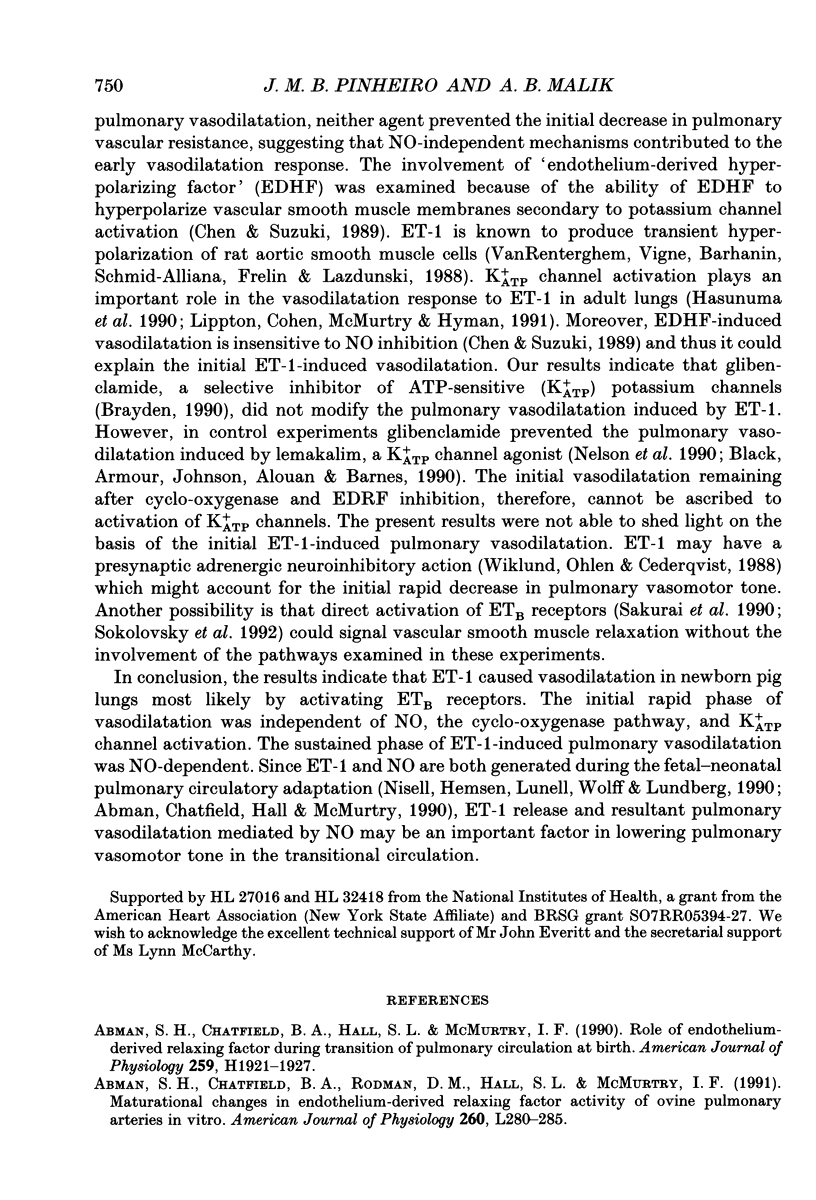
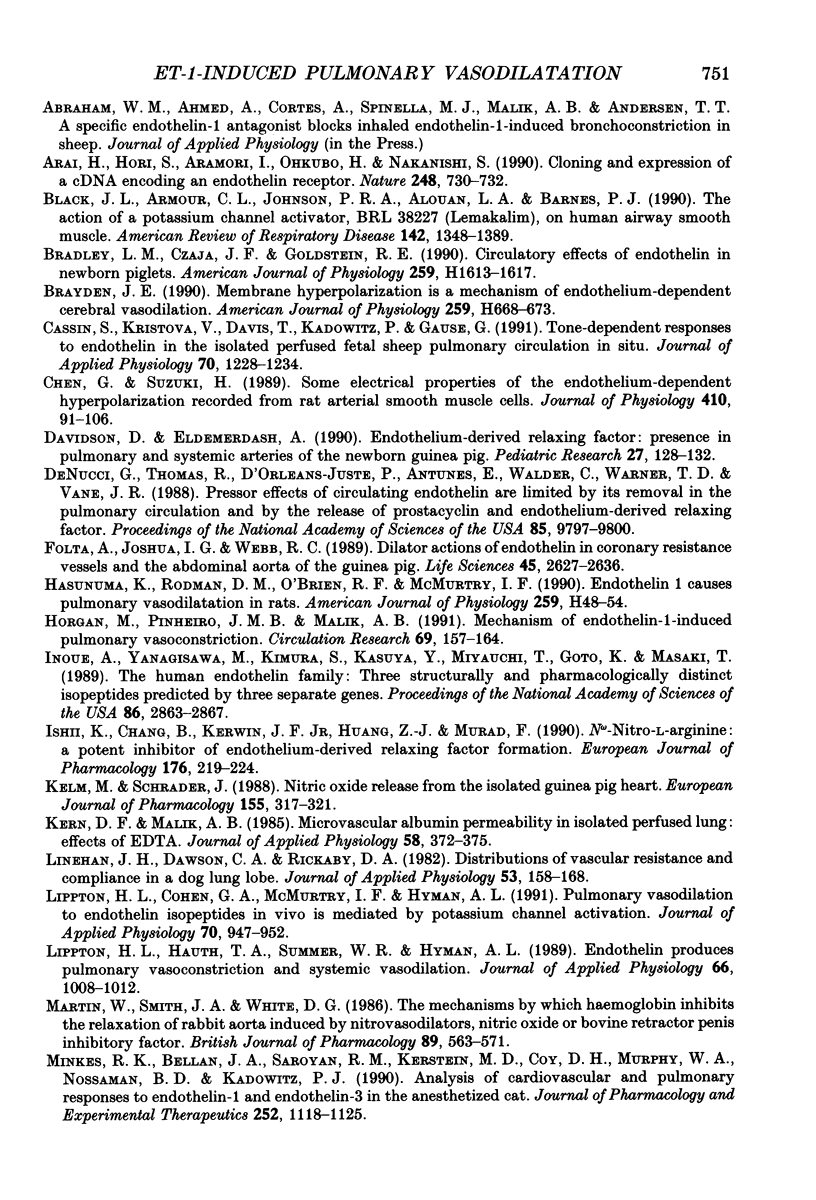
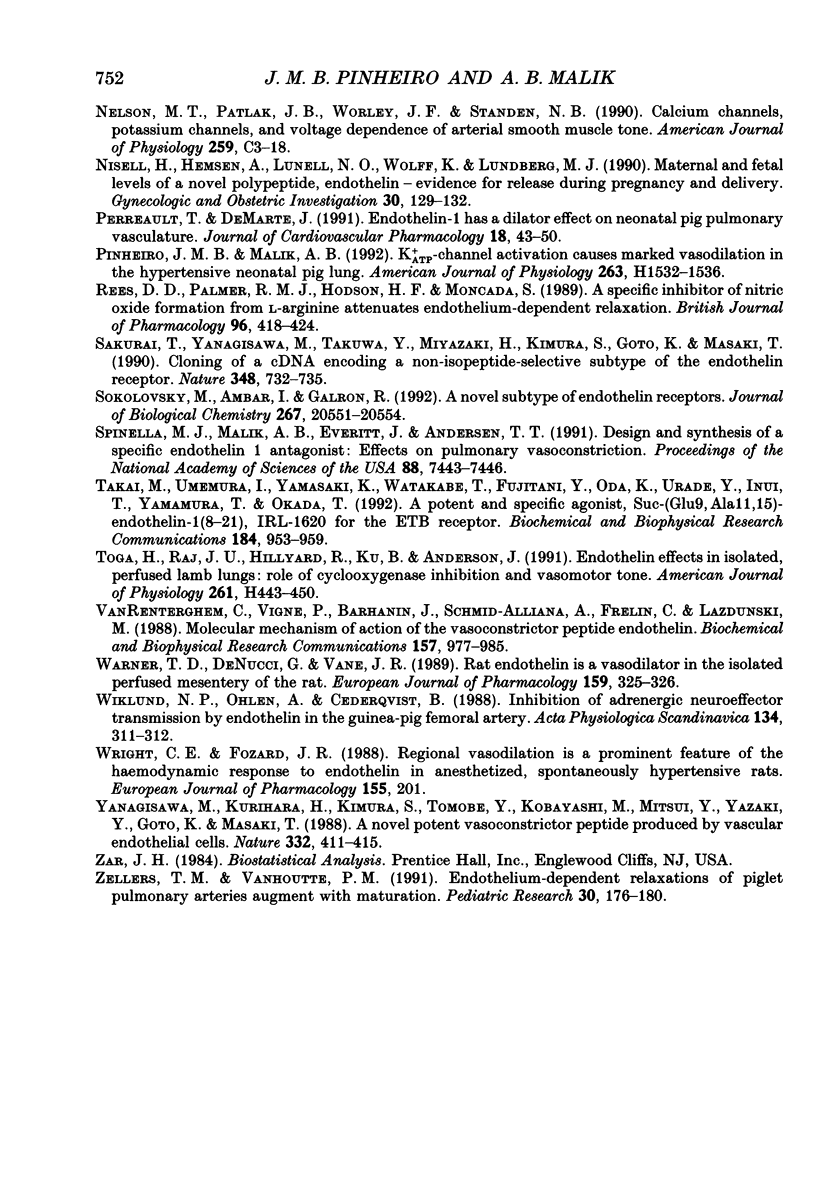
Images in this article
Selected References
These references are in PubMed. This may not be the complete list of references from this article.
- Abman S. H., Chatfield B. A., Hall S. L., McMurtry I. F. Role of endothelium-derived relaxing factor during transition of pulmonary circulation at birth. Am J Physiol. 1990 Dec;259(6 Pt 2):H1921–H1927. doi: 10.1152/ajpheart.1990.259.6.H1921. [DOI] [PubMed] [Google Scholar]
- Abman S. H., Chatfield B. A., Rodman D. M., Hall S. L., McMurtry I. F. Maturational changes in endothelium-derived relaxing factor activity of ovine pulmonary arteries in vitro. Am J Physiol. 1991 Apr;260(4 Pt 1):L280–L285. doi: 10.1152/ajplung.1991.260.4.L280. [DOI] [PubMed] [Google Scholar]
- Arai H., Hori S., Aramori I., Ohkubo H., Nakanishi S. Cloning and expression of a cDNA encoding an endothelin receptor. Nature. 1990 Dec 20;348(6303):730–732. doi: 10.1038/348730a0. [DOI] [PubMed] [Google Scholar]
- Black J. L., Armour C. L., Johnson P. R., Alouan L. A., Barnes P. J. The action of a potassium channel activator, BRL 38227 (lemakalim), on human airway smooth muscle. Am Rev Respir Dis. 1990 Dec;142(6 Pt 1):1384–1389. doi: 10.1164/ajrccm/142.6_Pt_1.1384. [DOI] [PubMed] [Google Scholar]
- Bradley L. M., Czaja J. F., Goldstein R. E. Circulatory effects of endothelin in newborn piglets. Am J Physiol. 1990 Nov;259(5 Pt 2):H1613–H1617. doi: 10.1152/ajpheart.1990.259.5.H1613. [DOI] [PubMed] [Google Scholar]
- Brayden J. E. Membrane hyperpolarization is a mechanism of endothelium-dependent cerebral vasodilation. Am J Physiol. 1990 Sep;259(3 Pt 2):H668–H673. doi: 10.1152/ajpheart.1990.259.3.H668. [DOI] [PubMed] [Google Scholar]
- Cassin S., Kristova V., Davis T., Kadowitz P., Gause G. Tone-dependent responses to endothelin in the isolated perfused fetal sheep pulmonary circulation in situ. J Appl Physiol (1985) 1991 Mar;70(3):1228–1234. doi: 10.1152/jappl.1991.70.3.1228. [DOI] [PubMed] [Google Scholar]
- Chen G., Suzuki H. Some electrical properties of the endothelium-dependent hyperpolarization recorded from rat arterial smooth muscle cells. J Physiol. 1989 Mar;410:91–106. doi: 10.1113/jphysiol.1989.sp017522. [DOI] [PMC free article] [PubMed] [Google Scholar]
- Davidson D., Eldemerdash A. Endothelium-derived relaxing factor: presence in pulmonary and systemic arteries of the newborn guinea pig. Pediatr Res. 1990 Feb;27(2):128–132. doi: 10.1203/00006450-199002000-00005. [DOI] [PubMed] [Google Scholar]
- Folta A., Joshua I. G., Webb R. C. Dilator actions of endothelin in coronary resistance vessels and the abdominal aorta of the guinea pig. Life Sci. 1989;45(26):2627–2635. doi: 10.1016/0024-3205(89)90248-8. [DOI] [PubMed] [Google Scholar]
- Hasunuma K., Rodman D. M., O'Brien R. F., McMurtry I. F. Endothelin 1 causes pulmonary vasodilation in rats. Am J Physiol. 1990 Jul;259(1 Pt 2):H48–H54. doi: 10.1152/ajpheart.1990.259.1.H48. [DOI] [PubMed] [Google Scholar]
- Horgan M. J., Pinheiro J. M., Malik A. B. Mechanism of endothelin-1-induced pulmonary vasoconstriction. Circ Res. 1991 Jul;69(1):157–164. doi: 10.1161/01.res.69.1.157. [DOI] [PubMed] [Google Scholar]
- Inoue A., Yanagisawa M., Kimura S., Kasuya Y., Miyauchi T., Goto K., Masaki T. The human endothelin family: three structurally and pharmacologically distinct isopeptides predicted by three separate genes. Proc Natl Acad Sci U S A. 1989 Apr;86(8):2863–2867. doi: 10.1073/pnas.86.8.2863. [DOI] [PMC free article] [PubMed] [Google Scholar]
- Ishii K., Chang B., Kerwin J. F., Jr, Huang Z. J., Murad F. N omega-nitro-L-arginine: a potent inhibitor of endothelium-derived relaxing factor formation. Eur J Pharmacol. 1990 Feb 6;176(2):219–223. doi: 10.1016/0014-2999(90)90531-a. [DOI] [PubMed] [Google Scholar]
- Kelm M., Schrader J. Nitric oxide release from the isolated guinea pig heart. Eur J Pharmacol. 1988 Oct 18;155(3):317–321. doi: 10.1016/0014-2999(88)90522-5. [DOI] [PubMed] [Google Scholar]
- Kern D. F., Malik A. B. Microvascular albumin permeability in isolated perfused lung: effects of EDTA. J Appl Physiol (1985) 1985 Feb;58(2):372–375. doi: 10.1152/jappl.1985.58.2.372. [DOI] [PubMed] [Google Scholar]
- Linehan J. H., Dawson C. A., Rickaby D. A. Distribution of vascular resistance and compliance in a dog lung lobe. J Appl Physiol Respir Environ Exerc Physiol. 1982 Jul;53(1):158–168. doi: 10.1152/jappl.1982.53.1.158. [DOI] [PubMed] [Google Scholar]
- Lippton H. L., Cohen G. A., McMurtry I. F., Hyman A. L. Pulmonary vasodilation to endothelin isopeptides in vivo is mediated by potassium channel activation. J Appl Physiol (1985) 1991 Feb;70(2):947–952. doi: 10.1152/jappl.1991.70.2.947. [DOI] [PubMed] [Google Scholar]
- Lippton H. L., Hauth T. A., Summer W. R., Hyman A. L. Endothelin produces pulmonary vasoconstriction and systemic vasodilation. J Appl Physiol (1985) 1989 Feb;66(2):1008–1012. doi: 10.1152/jappl.1989.66.2.1008. [DOI] [PubMed] [Google Scholar]
- Martin W., Smith J. A., White D. G. The mechanisms by which haemoglobin inhibits the relaxation of rabbit aorta induced by nitrovasodilators, nitric oxide, or bovine retractor penis inhibitory factor. Br J Pharmacol. 1986 Nov;89(3):563–571. doi: 10.1111/j.1476-5381.1986.tb11157.x. [DOI] [PMC free article] [PubMed] [Google Scholar]
- Minkes R. K., Bellan J. A., Saroyan R. M., Kerstein M. D., Coy D. H., Murphy W. A., Nossaman B. D., McNamara D. B., Kadowitz P. J. Analysis of cardiovascular and pulmonary responses to endothelin-1 and endothelin-3 in the anesthetized cat. J Pharmacol Exp Ther. 1990 Jun;253(3):1118–1125. [PubMed] [Google Scholar]
- Nelson M. T., Patlak J. B., Worley J. F., Standen N. B. Calcium channels, potassium channels, and voltage dependence of arterial smooth muscle tone. Am J Physiol. 1990 Jul;259(1 Pt 1):C3–18. doi: 10.1152/ajpcell.1990.259.1.C3. [DOI] [PubMed] [Google Scholar]
- Nisell H., Hemsén A., Lunell N. O., Wolff K., Lundberg M. J. Maternal and fetal levels of a novel polypeptide, endothelin: evidence for release during pregnancy and delivery. Gynecol Obstet Invest. 1990;30(3):129–132. doi: 10.1159/000293236. [DOI] [PubMed] [Google Scholar]
- Perreault T., De Marte J. Endothelin-1 has a dilator effect on neonatal pig pulmonary vasculature. J Cardiovasc Pharmacol. 1991 Jul;18(1):43–50. doi: 10.1097/00005344-199107000-00007. [DOI] [PubMed] [Google Scholar]
- Pinheiro J. M., Malik A. B. K+ATP-channel activation causes marked vasodilation in the hypertensive neonatal pig lung. Am J Physiol. 1992 Nov;263(5 Pt 2):H1532–H1536. doi: 10.1152/ajpheart.1992.263.5.H1532. [DOI] [PubMed] [Google Scholar]
- Rees D. D., Palmer R. M., Hodson H. F., Moncada S. A specific inhibitor of nitric oxide formation from L-arginine attenuates endothelium-dependent relaxation. Br J Pharmacol. 1989 Feb;96(2):418–424. doi: 10.1111/j.1476-5381.1989.tb11833.x. [DOI] [PMC free article] [PubMed] [Google Scholar]
- Sakurai T., Yanagisawa M., Takuwa Y., Miyazaki H., Kimura S., Goto K., Masaki T. Cloning of a cDNA encoding a non-isopeptide-selective subtype of the endothelin receptor. Nature. 1990 Dec 20;348(6303):732–735. doi: 10.1038/348732a0. [DOI] [PubMed] [Google Scholar]
- Sokolovsky M., Ambar I., Galron R. A novel subtype of endothelin receptors. J Biol Chem. 1992 Oct 15;267(29):20551–20554. [PubMed] [Google Scholar]
- Spinella M. J., Malik A. B., Everitt J., Andersen T. T. Design and synthesis of a specific endothelin 1 antagonist: effects on pulmonary vasoconstriction. Proc Natl Acad Sci U S A. 1991 Aug 15;88(16):7443–7446. doi: 10.1073/pnas.88.16.7443. [DOI] [PMC free article] [PubMed] [Google Scholar]
- Takai M., Umemura I., Yamasaki K., Watakabe T., Fujitani Y., Oda K., Urade Y., Inui T., Yamamura T., Okada T. A potent and specific agonist, Suc-[Glu9,Ala11,15]-endothelin-1(8-21), IRL 1620, for the ETB receptor. Biochem Biophys Res Commun. 1992 Apr 30;184(2):953–959. doi: 10.1016/0006-291x(92)90683-c. [DOI] [PubMed] [Google Scholar]
- Toga H., Usha Raj J., Hillyard R., Ku B., Anderson J. Endothelin effects in isolated, perfused lamb lungs: role of cyclooxygenase inhibition and vasomotor tone. Am J Physiol. 1991 Aug;261(2 Pt 2):H443–H450. doi: 10.1152/ajpheart.1991.261.2.H443. [DOI] [PubMed] [Google Scholar]
- Van Renterghem C., Vigne P., Barhanin J., Schmid-Alliana A., Frelin C., Lazdunski M. Molecular mechanism of action of the vasoconstrictor peptide endothelin. Biochem Biophys Res Commun. 1988 Dec 30;157(3):977–985. doi: 10.1016/s0006-291x(88)80970-7. [DOI] [PubMed] [Google Scholar]
- Warner T. D., de Nucci G., Vane J. R. Rat endothelin is a vasodilator in the isolated perfused mesentery of the rat. Eur J Pharmacol. 1989 Jan 17;159(3):325–326. doi: 10.1016/0014-2999(89)90167-2. [DOI] [PubMed] [Google Scholar]
- Wiklund N. P., Ohlén A., Cederqvist B. Inhibition of adrenergic neuroeffector transmission by endothelin in the guinea-pig femoral artery. Acta Physiol Scand. 1988 Oct;134(2):311–312. doi: 10.1111/j.1748-1716.1988.tb08495.x. [DOI] [PubMed] [Google Scholar]
- Wright C. E., Fozard J. R. Regional vasodilation is a prominent feature of the haemodynamic response to endothelin in anaesthetized, spontaneously hypertensive rats. Eur J Pharmacol. 1988 Oct 11;155(1-2):201–203. doi: 10.1016/0014-2999(88)90425-6. [DOI] [PubMed] [Google Scholar]
- Yanagisawa M., Kurihara H., Kimura S., Tomobe Y., Kobayashi M., Mitsui Y., Yazaki Y., Goto K., Masaki T. A novel potent vasoconstrictor peptide produced by vascular endothelial cells. Nature. 1988 Mar 31;332(6163):411–415. doi: 10.1038/332411a0. [DOI] [PubMed] [Google Scholar]
- Zellers T. M., Vanhoutte P. M. Endothelium-dependent relaxations of piglet pulmonary arteries augment with maturation. Pediatr Res. 1991 Aug;30(2):176–180. doi: 10.1203/00006450-199108000-00011. [DOI] [PubMed] [Google Scholar]
- de Nucci G., Thomas R., D'Orleans-Juste P., Antunes E., Walder C., Warner T. D., Vane J. R. Pressor effects of circulating endothelin are limited by its removal in the pulmonary circulation and by the release of prostacyclin and endothelium-derived relaxing factor. Proc Natl Acad Sci U S A. 1988 Dec;85(24):9797–9800. doi: 10.1073/pnas.85.24.9797. [DOI] [PMC free article] [PubMed] [Google Scholar]



